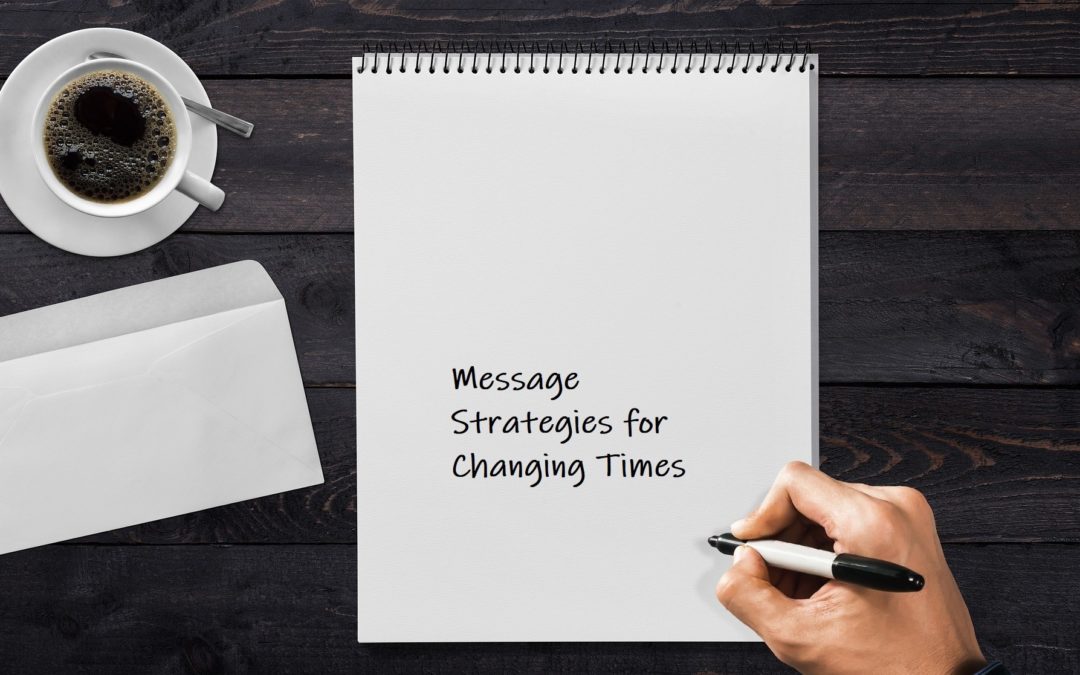Recently, as organizations everywhere were busy reacting to fast-breaking COVID developments, many had questions about “pivoting” their message. I considered taking on that topic here, but realized that the idea is too narrow. Pivoting suggests a single quick move in a new direction, but as recent history has taught us, no one-time readjustment can keep you well-positioned in a world so constantly in motion—where viruses, social movements, economics, and politics present us with historic new realities every day.
For all of us focused on sending the right messages to donors, the goal is not to pivot, but to continually adapt and adjust. It’s to keep updating your story so that it makes sense in the moment, so that it speaks directly to your audience’s present concerns, and so that it positions your organization for success in a changing environment. My goal in this article is to share some advice about how to achieve all this, how to shape an effective messaging strategy in a time of rapid change.
Expressing Your Message With Fresh Relevance
If you are a mission-driven organization, then your mission is the starting point for your message—not your mission statement, but the larger story of why you do what you do and why it matters. In fast-evolving times, telling that story well means articulating why your mission matters now.
Why does it matter now—possibly more than ever? Here are a few leads on finding the answer:
- Think about people hurt by the current crisis, directly or indirectly, and how you are helping them or how you could be. (An area charter school focused a recent appeal on buying computers for disadvantaged kids unable to take part in distance learning.)
- Think about ways your work will be important in the months to come, even if it’s been interrupted for now. (A Philadelphia human services organization is launching an emergency fund to ramp up its job training programs, which will soon be vital in helping tens of thousands of people to restart their lives.)
- Think about the beliefs your organization stands for and how headline events are spotlighting their importance. (Advocacy groups working for people who are marginalized have the chance to connect their work to a national movement for change unfolding on a historic scale.)
Mission relevance can be expressed less directly too. Arts organizations can assert their relevance by reminding us of the power of creative expression to bring meaning into people’s lives, especially in difficult times. Conservation groups can celebrate the peace and inspiration we find in nature. Many organizations in both these spheres have shared memorable original content in recent weeks, from Yo-Yo Ma’s live performance of Bach’s cello suites on public radio, a musical memorial and tribute, to webcam feeds of nesting red-tail hawks from the Cornell Ornithology Lab.
Expressing your mission in fresh terms can sometimes be a matter of re-emphasizing familiar themes. For instance, many public health organizations have long seen issues of social equity as inseparable from their goals of providing access to care. Now, with a dialogue on social justice taking center stage nationally, these organizations can stress this message for audiences primed to receive it.
Communicating the Right Degree of Urgency
One of the most common questions we’ve recently heard at Schultz & Williams concerns how much urgency nonprofits should express in their messaging.
It’s actually worth answering this question twice because there are really two kinds of urgency at issue. The first is about urgent needs that organizations are working to address. For JEVS Human Services, the group I mentioned earlier that’s launching an emergency fund to support job training programs, the urgency is about vulnerable people who are out of work and facing the toughest employment market since the Great Depression. To inspire support, it is necessary to make clear the damage the pandemic has done and the risks of food insecurity and homelessness. JEVS is doing so—while offering donors a clear way to help.
The messaging approach in a situation like this should be to speak with an honest degree of urgency, reporting the situation without overstatement and balancing alarm with a note of hope.
The second, very different, kind of urgency is organizational. It relates to the pressing budgetary stresses many nonprofits are facing right now. I’ve spoken with several of my S&W colleagues about the communications challenge this situation presents, and our consensus is this: It is appropriate to acknowledge this kind of financial stress as long as you avoid sparking alarm. However, whatever your needs may be, it’s even more important to talk about your plan. You have to explain to your donors the actions you intend to take to meet your present challenges. Then you can ask them to help you do so. (As with so many conversations these days, this leads us to the priority of strategic planning and how to update your plans quickly, the topic of a recent article by my colleague Lauren Hansen-Flaschen.)
When you are thinking about a note of urgency in your messaging, it’s also key to think about how long you can sustain that note. Urgent messages command attention and spark action, but they also become fatiguing. Before long, your conversation with donors will need to evolve beyond the mode of crisis communications.
Enriching the Content Stream
In times of crisis, it is natural that your communications to donors predominantly fall into two types: operational updates and gift solicitations. Afterall, constituents want to know how your organizations is faring, and you need to sustain your gift income. However, as months pass and the present pandemic begins to feel like a chronic condition we will be living with for some time, you need to shift beyond a steady menu of updates and asks to keep your audience engaged and make your voice heard above all the competing appeals.
With the present public health situation, this is a challenge made more pressing by the fact that many traditional forms of donor engagement are off the table, from galas and face-to-face meetings, to performances and on-site programming.
One way to compensate is with robust online offerings. A university may launch faculty roundtables exploring issues from the headlines. A public garden may make its general education courses virtual. A theater company might commission a work exploring timely themes or conceived specifically for the strange stage of the Zoom room. These are all promising options. But they also represent significant investments. So in addition to these major initiatives, it’s worth exploring other options for enriching your content stream, such as engaging storytelling. Whether through text, photos, audio, or video, your goal should be to develop stories that spotlight your people and programs, that show your mission in action, and that illustrate your impact. These should feel more like magazine feature content in their topic and approach than run-of-the-mill newsletter items. They should be vivid and varied and interesting.
As you try different approaches, be sure to measure your results. Your open rates and click-throughs will help you discover the kind of story your audiences most want to hear.
As I look back on the guidance I’ve shared here, I realize that the best practices for dealing with this particularly challenging communications situation are, in fact, best practices in general. Whether in the midst of pandemics, protests, recessions, and elections or during more ordinary times, it’s wise to think about expressing the real-time relevance of your mission, about communicating urgency in the right degree, and about bringing your work to life through engaging stories. These are always good messaging approaches, just as readiness to readjust is always a smart stance. Even when life feels more stable than it does right now, all times are changing times.




